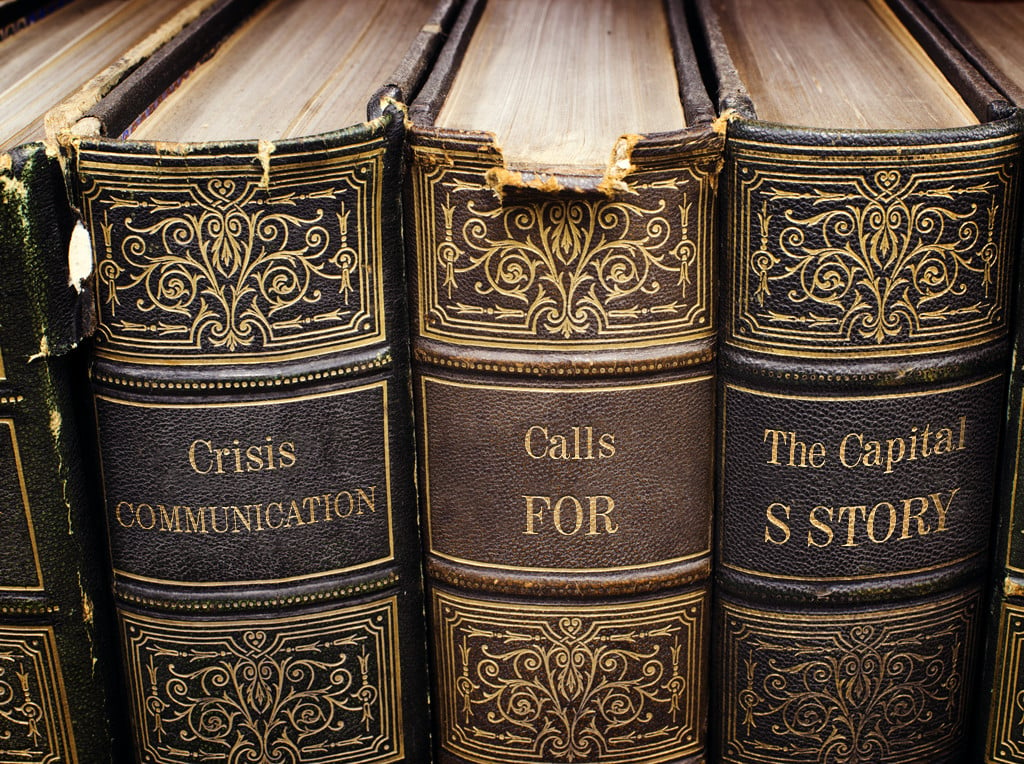
Check your phone, computer or TV: Everywhere you look these days, it’s crisis, crisis, crisis. Sometimes it looks as if every pocket of our world is lurching from crisis to crisis.
Chances are a business will be hit with a crisis one day, so it might seem odd to suggest that during these times the most important communication asset any business leader must focus on is the core story of the organization. Decades of science and years of our own experience, however, prove this is true.
In any given year, our firm handles 12 major crises, ten that never make the news, and two that are all over the news. As I write this, one of our favorite clients is in the midst of a true tragedy that’s all over the news, making this especially fresh in my mind.
So when I tell you that your focus during any crisis that befalls your organization must ultimately turn back to sharing your core story, I’m coming from a place rooted in science and in the painful experience of somebody who spends a lot of time with smart leaders who are forced to communicate during truly terrible situations.
Let's unwrap the importance of storytelling during a tragedy by understanding the dynamics of a crisis.
There are only four types of crises
Regardless of what thousands of consultants, lawyers and pundits have proclaimed over the years, there are really only four types of crises:
- Acts of God
- Acts of Man
- Acts of God, made worse by man
- Acts of Man, made worse by God
Let’s bring this to life with a few examples.
A hurricane is an act of God. A hurricane that causes torrential flooding and inundates a Texas chemical plant filled with toxic liquids that explode when they contact water is an act of God made worse by man.
An oil pipeline rupture below the Gulf of Mexico is an act of man that’s made worse by God when storms spread the pollution caused by the rupture.
If there are only four major categories of crises, it stands to reason that a business leader might be able to more proactively plan to deal with them in the unfortunate instance when a crisis hits. And if you can plan ahead for the types of crises you might face, you could certainly develop appropriate plans to communicate your story when a crisis hits.
But that’s not even the most important point about the importance of storytelling during a crisis.
Most crises are predictable
More than 70 years ago, in the midst of World War II, university research produced a startling conclusion: 95 percent of crises are predictable. In the modern era, the predictability of human behavior has been confirmed with even more technological precision. Sadly, scientists say they can even predict genocide, a particularly horrible “act of man” crisis.
This kind of information was certainly valuable in the context of winning a war. Now think about it in regard to our two examples. If you locate a chemical plant storing chemicals that explode when they contact water in an area that might flood … is it truly impossible to believe this scenario might happen?
And if you’re going to drill for oil 10,000 feet below the surface of the Gulf of Mexico, how unlikely is it to consider that one of the pipes might rupture while pumping that oil to the surface under the immense pressures of the Gulf’s waters?
Look at it this way: Who would operate a business without insurance? So why would a smart business leader operate without “communication insurance” to deal with whatever mishap it’s already paying mightily to address through its insurance premiums?
‘Sunny day’ planning eases crises
A question logically follows from this idea of “crisis communication insurance.” When is the best time to plan your crisis communication? Trick question with a simple answer: When you’re not facing a crisis. This concept is known in the crisis management profession as “sunny day planning,” as in, get yourself prepared before the storm hits.
Businesses apply this thinking to risk management in many forms, including the insurance policies that protect their people and their facilities. It should be no different with their crisis communications.
Yes, but what kind of communication preparation? I’m not talking about the tactical implementation of communication. If you’re looking for guidance on press releases, or crisis drills, time to stop reading. Those are table stakes. That discussion should come later. Deciding what your press release says right away is kind of like picking the color of your interior walls before you’ve developed the drawings for your new house. First things first, right?
We’re talking about the story behind your crisis communications, the one that will provide the best path through the crisis minefield. And that’s a very special story.
Introducing your Capital S Story
The most important story your organization owns is what we call your Capital S Story. It’s the story above all stories, the one that answers the question of why someone would buy from you, work for you, invest in you, partner with you or, in the case of say, locating a chemical plant, be your neighbor. For example, Southwest Airlines answers these Capital S Story questions through its corporate vision: “to become the world’s most loved, most flown, and most profitable airline.”
Why is your Capital S Story important in a crisis? Because:
- Everything in a crisis is compressed by time.
- This time compression compels you to quickly establish credibility, and your Capital S Story does this.
- Your Capital S Story is your REAL story, and it allows you to remind your audiences who you are and what your organization really stands for, instead of just using your crisis communications to react to developments that you can’t control (if you could control them, it wouldn’t be a crisis, right?).
Defining synaptic shortcuts
Uncovering and understanding your Capital S Story is an important step in your overall communications. In the context of a crisis, it’s the application of the Capital S Story that’s most important.
I used a term we’ve coined in the subhead above, “synaptic shortcut.” For our purposes, a synaptic shortcut is a concept, an idea, a story that doesn’t need explanation. For example, David and Goliath is a story from the Bible that, even if you aren’t a Bible scholar, you probably understand: The little guy against the big guy. (Read this blog if you want to know more about synaptic shortcuts).
Having a crystal-clear Capital S Story for your organization allows your audiences in any crisis to remember who you are and what you stand for, giving you a synaptic shortcut that you can leverage in the pressure cooker of a fast-moving crisis.
Think for a moment: The last time you heard of a terrible crisis involving a company, what did you do? Most likely, you hit the internet and did a Google search, right? If the first 10 results about that organization tell the world nothing about who they are and what the organization stands for, that Google search is going to turn up nothing but breaking news that suggests the organization is a bad actor responsible for the current crisis.
Having a clear Capital S Story and articulating it before a crisis hits creates deposits in what we call the “bank of goodwill,” a reservoir of reputation that says your organization is trustworthy. To paraphrase the title of a popular book from several decades ago, bad things happen to good organizations. When they do, those organizations want their audiences to remember they are good organizations. So how do they accomplish that?
In a crisis, it’s about the heroes and villains
Let’s return briefly to David and Goliath. In this classic story, David is the hero and Goliath is the villain. It’s a fact of modern life (unfortunately supported by too many examples), that the immediate public reaction to an organization when it’s hit with a crisis is to assume that it’s a villain.
A clearly developed and articulated Capital S Story demonstrates that your organization is a hero. In the heat of a crisis, your Capital S Story should help your audiences understand that yours is a good organization that’s now had something bad happen to it.
When a crisis hits, your audiences will immediately employ their own “synaptic shortcuts.” They will be assessing your organization in the context of recent similar crises.
Here’s one example. For the last decade or so, the for-profit postsecondary education industry has been under fire for a whole raft of issues. As specific companies in the industry have been indicted or sued or shut down, the news media and stakeholders naturally turn to the other institutions in the industry and ask the question, “Are these other for-profit schools villains, just like the one that was indicted?”
The focus of Capital S Story development in proactive crisis communications is to share your story in ways that prove your organization is like the heroes in your industry, not like the villains. By effectively making this your North Star at the very highest level of your crisis communication planning, you will be building the foundation to quickly align your organization with trusted leaders in your industry.
It should play out like this: Upon learning that something bad has happened involving your organization, your stakeholders ideally think, “Oh my, this is bad news. But everything I know about this organization tells me they are one of the good guys in this industry. For now, I’m going to give them the benefit of the doubt.”
Your story is your roadmap
Please note I am not suggesting that the quality of your clearly articulated Capital S Story will absolve you of doing the right thing in a crisis. I am not saying you can do a bad job of addressing the crisis or just paper over a poor response to a crisis with a great story.
I am saying that clearly articulating your great story gives the audiences important to you something positive to hold on to while you do the right thing in managing the crisis. It gives them something to consider instead of immediately trashing you on social media because you haven’t shared a clear and compelling narrative about what happened and what you’re doing about it.
That clearly articulated Capital S Story, when developed through crisis communications that align your organization with the good guys in your industry, will also give you a roadmap through the minefield, a touchstone to return to time and again as you navigate the crisis.
Ideally, at every appropriate point in your crisis communications, you should use your Capital S Story to remind the audiences important to you of the true nature of your organization. That’s the touchstone that will enable your organization to exit the crisis minefield with your reputation intact.
Storytelling in a crisis is about authenticity, about fluent storytelling, and about engaging your audiences. A crisis can bruise you; it can damage your organization’s reputation. But it doesn’t have to kill it — especially if you understand your Capital S Story and you’re willing to share it, long before you find yourself in crisis.
